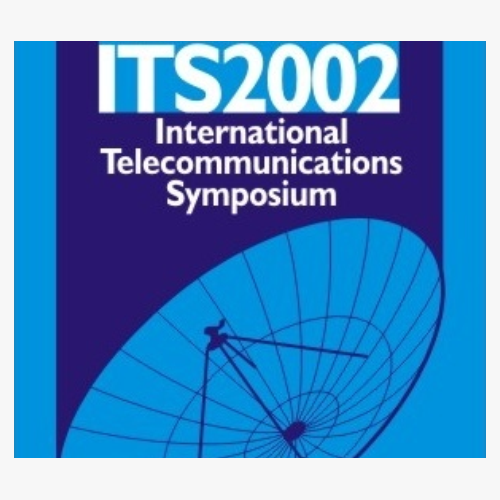
2002 International Telecommunications Symposium
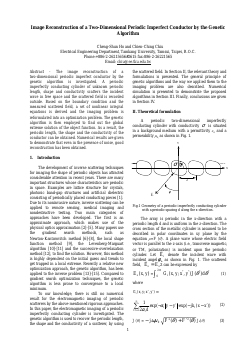
Image Reconstruction of a Two-Dimensional Periodic Imperfect Conductor by the Genetic Algorithm
Cheng-Shun Ho, Chien-Ching Chiu
DOI: 10.14209/its.2002.494
Keywords:
Abstract
"The image reconstruction of a two-dimensional periodic imperfect conductor by the genetic algorithm is investigated. A periodic imperfectly conducting cylinder of unknown periodic length, shape and conductivity scatters the incident wave in free space and the scattered field is recorded outside. Based on the boundary condition and the measured scattered field, a set of nonlinear integral equations is derived and the imaging problem is reformulated into an optimization problem. The genetic algorithm is then employed to find out the global extreme solution of the object function. As a result, the periodic length, the shape and the conductivity of the conductor can be obtained. Numerical results are given to demonstrate that even in the presence of noise, good reconstruction has been obtained. "Download
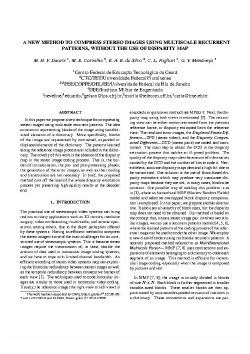
A New Method to Compress Stereo Images using Multiscale Recurrent Patterns without the use of Disparity Map
M. H. V. Duarte, M. B. Carvalho, E. A. B. da Silva, C. L. Pagliari, G. V. Mendonca
DOI: 10.14209/its.2002.499
Keywords:
Abstract
"In this paper we propose a new technique for compressing stereo images using multiscale recunent patterns. The idea consists on representing blocks of the image using variable- sized elements of a dictionary. More specifically, blocks of the image ave represented by contracted, expanded or displaced elements of the dictionary. The patterns learned along the reference image process are included in the dictionary. The novelty of this work is the absence of the disparity map in the stereo image coding process. That is, the burden of its calculation, the pre- and post-processing phases, the generation of the error images, as well as their coding and transmission ave not necessary. In brief, the proposed method cuts off the load of the whole disparity estimation process yet presenting high-quality results at the decoder end."Download

A Video Encoder Based on Generalized Bit-Planes
Rogério Caetano, Eduardo A. B. da Silva, Alexandre G. Ciancio
DOI: 10.14209/its.2002.505
Keywords:
Abstract
"Among the best performing video coding methods are the ones based on the matching pursuits algorithm. In them, the motion compensated frame difference is decomposed on an overcomplete dictionary of atoms in a greedy fashion. It is represented by a sequence of pairs specifying the atoms used and their corresponding coefficients. The rate distortion trade-off is achieved by varying both the number of atoms and how the coefficients are quantized. Several strategies have been presented in order to solve the problem of, given a target rate or distortion, determining the optimum number of atoms as well as the quantizers of the corresponding coefficients. In this paper we propose a novel method for performing matching pursuits quantization, based on the notion of decomposition in generalized bit-planes. The structure of such decompositions is such that once the decomposition is carried out, it is already quantized, and there is no need to set up any quantization parameters. It does so by generating a decomposition that is readily organized in bit-planes. It provides an elegant solution to the trade-off between quantization of coefficients and number of passes in the matching pursuits algorithm. In fact, we show that it can be regarded as a generalization of any decomposition on a dictionary followed by linear quantization of the coefficients. In addition, we present a theorem that sets bounds for the R-D performance of such generalized decompositions. We test the effectiveness of the proposed method using the framework of Neff and Zakhor\u2019s matching pursuits video encoder. The results obtained are promising, presenting, without any ad-hoc assumptions about the R-D behavior of the coded frames or any increase in computational complexity, a significant improvement over the classical matching pursuits video coders. Also, the results are as good as the ones obtained employing more sophisticated strategies."Download

Embedded DCT Image Encoding
Fabrício C. de A. Oliveira, Max H. M. Costa
DOI: 10.14209/its.2002.511
Keywords: DCT run-length coding embedded coding block image coding JPEG MPEG
Abstract
"This article introduces a new image coding scheme based on the discrete cosine transform (DCT) applied to blocks of image pixels and on the run-length encoding of the binary digits of the DCT coefficients, bitplane by bit-plane. The main advantages of this new algorithm are: simplicity of implementation, efficiency superior to JPEG’s, in peak-signal-tonoise ratio (PSNR) versus bit rate, fully embedded output sequence, and all the advantages that result from the use of the DCT as the coding transform, as, for example, the possibility to be used as part of a video coder with block motion compensation, such as MPEG."Download
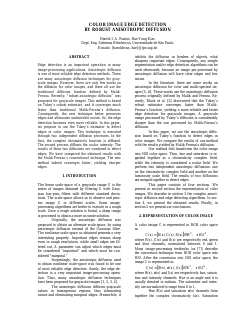
Color Image Edge Detection by Robust Anisotropic Diffusion
Harold I. A. Bustos, Hae Yong Kim.
DOI: 10.14209/its.2002.515
Keywords:
Abstract
"Edge detection is an important operation in many image-processing applications. Anisotropic diffusion is one of most reliable edge detection methods. There are many anisotropic diffusion techniques for grayscale images. However, there are only few works on the diffusion for color images, and these all use the traditional diffusion function defined by MalikPerona. Recently, \u201crobust anisotropic diffusion\u201d was proposed for grayscale images. This method is based on Tukey\u2019s robust estimator, and it converges much faster than traditional Malik-Perona\u2019s diffusion. Consequently, the new technique better preserves edges and attenuates undesirable noises. So, the edge detection becomes even more reliable. In this paper, we propose to use the Tukey\u2019s estimator to detect edges in color images. This technique is executed through two independent diffusion processes. In the first, the complex chromaticity function is diffused. The second process diffuses the scalar intensity. The results of these two diffusions are combined to detect edges. We have compared the obtained results with the Malik-Perona\u2019s conventional technique. The new method indeed converges faster, yielding sharper edges."Download
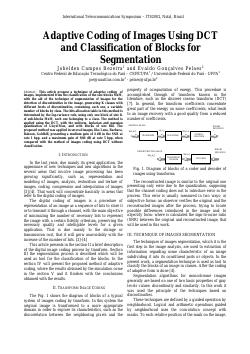
Adaptive Coding of Images Using DCT and Classification of Blocks for Segmentation
Johelden Campos Bezerra, Evaldo Gonçalves Pelaes
DOI: 10.14209/its.2002.521
Keywords:
Abstract
"This article propose a technique of adaptive coding of images, implemented from the classification of the size blocks MxM, with the aid of the technique of segmentation of images for the detection of discontinuities in the image, generating K classes with different levels of discontinuities, containing, each one, a variable number of blocks by class. The bits allocation table in this method is determined by the log-variance rule, using only one block of size K of sub-blocks MxM, each one belonging to a class. The method is applied using the DCT, with the uniform, laplacian and gaussian quantization of Lloyd-Max, and with blocks of size 8x8. The proposed method was applied in several images, like Lena, Barbara, Baboon, Goldhill, presenting a medium gain of 4 dB in the SNR at rate 1 bpp, and a maximum gain of 9,04 dB at rate 5 bpp, when compared with the method of images coding using DCT without classification."Download
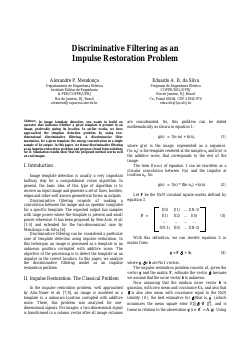
Discriminative Filtering as an Impulse Restoration Problem
Alexandre P. Mendonça, Eduardo A. B. da Silva
DOI: 10.14209/its.2002.527
Keywords:
Abstract
"In image template detection, one wants to build an operator that indicates whether a given template is present in an image, preferably giving its location. In earlier works, we have approached the template detection problem by using two dimensional discriminative filtering. A discriminative filter maximizes, for a given template, the energy concentration in a single sample of its output. In this paper, we frame discriminative filtering as an impulse restoration problem and propose closed form solutions for it. Simulation results show that the proposed method works well on real images."Download
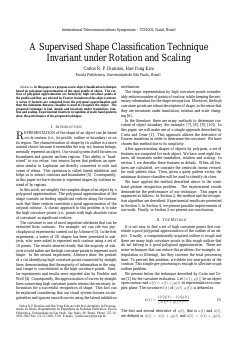
A Supervised Shape Classification Technique Invariant under Rotation and Scaling
Carlos R. P. Dionisio, Hae Yong Kim
DOI: 10.14209/its.2002.532
Keywords:
Abstract
"In this paper, we propose a new object classification technique based on polygonal approximation of the open profile of object. The vertices of polygonal approximation are formed by high curvature points of the profile and they are selected by Fourier transform of the object contour. A series of features are computed from the polygonal approximation and then the minimum distance classifier is used to recognize the object. The proposed technique is fast, simple and invariant under translation, rotation and scaling. Experimental results in recognition of static hand gestures show the performance of the proposed technique."Download

A New QoS Mapping Mechanism for MPEG Video Transport in a DiffServ Domain
Johann M. H. Magalhães, Paulo R. Guardieiro
DOI: 10.14209/its.2002.537
Keywords:
Abstract
"In this paper, we present a new QoS mapping mechanism for MPEG video transport in a DiffServ domain. In this mechanism, QoS indexes are defined based on the loss and delay requirements of each video flow. In agreement with these QoS indexes, the video packets are mapped in the classes of the AF service. The efficiency of this mechanism was evaluated by means of modeling and simulation of MPEG -4 video transmission over a DiffServ domain. The results show that the proposed QoS mapping can take advantages of the DiffServ architecture, making possible an improvement in the video quality according to the user and application needs."Download

Non-Causal Prediction for Lossless Coding of Images
Milton Simas Gonçalves Torres, Paulo Roberto Rosa Lopes Nunes
DOI: 10.14209/its.2002.543
Keywords:
Abstract
"In this work it is presented a lossless image coding method using a non-causal and non-linear prediction scheme. As in most lossless methods, each pixel is predicted from values of neighbors, and the differences between actual and predicted values are entropy coded. In the proposed method, prediction is not based only on pixels that have already been coded; pixels not coded yet can also be used. The nonlinear prediction scheme requires the storage of additional information. The amount of this side information however, is not significant. The method has been compared with state of the art lossless image coding schemes and good results were obtained."Download